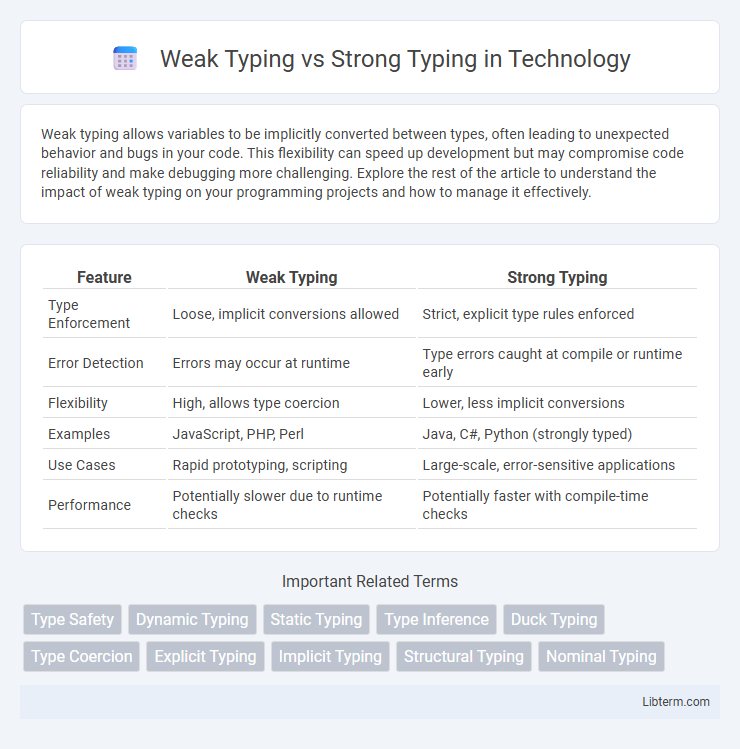Weak typing allows variables to be implicitly converted between types, often leading to unexpected behavior and bugs in your code. This flexibility can speed up development but may compromise code reliability and make debugging more challenging. Explore the rest of the article to understand the impact of weak typing on your programming projects and how to manage it effectively.
Table of Comparison
| Feature | Weak Typing | Strong Typing |
|---|---|---|
| Type Enforcement | Loose, implicit conversions allowed | Strict, explicit type rules enforced |
| Error Detection | Errors may occur at runtime | Type errors caught at compile or runtime early |
| Flexibility | High, allows type coercion | Lower, less implicit conversions |
| Examples | JavaScript, PHP, Perl | Java, C#, Python (strongly typed) |
| Use Cases | Rapid prototyping, scripting | Large-scale, error-sensitive applications |
| Performance | Potentially slower due to runtime checks | Potentially faster with compile-time checks |
Introduction to Data Typing in Programming
Data typing in programming defines how data is classified and managed within a language, impacting variable behavior and type safety. Weak typing allows implicit type conversions, enabling flexible but potentially error-prone operations, whereas strong typing enforces strict adherence to data types, reducing bugs by preventing unintended conversions. Understanding the distinction between weak and strong typing is essential for selecting appropriate languages and writing robust, maintainable code.
Defining Weak Typing
Weak typing refers to a programming language characteristic where types are implicitly converted or coerced between incompatible types without explicit declaration, often leading to unpredictable behavior or runtime errors. Languages like JavaScript and PHP exemplify weak typing by allowing operations between different data types, such as adding a string to a number, which may produce unintended results. Understanding weak typing is crucial for debugging and maintaining code, especially in dynamic typing environments where type safety is not strictly enforced.
Defining Strong Typing
Strong typing enforces strict type rules, ensuring variables are only assigned compatible values, which reduces type-related errors during runtime. Languages like Python, Java, and Haskell exemplify strong typing by performing rigorous type checking at compile-time or runtime. This approach enhances code reliability and maintainability by preventing implicit type coercion and unexpected behavior.
Key Differences Between Weak and Strong Typing
Weak typing allows implicit type conversion, often leading to unpredictable behavior and subtle bugs, whereas strong typing enforces strict type rules, preventing unauthorized or unintended operations between incompatible types. In weakly typed languages like JavaScript or PHP, types can be coerced automatically during runtime, whereas strongly typed languages like Java or Rust require explicit conversions, enhancing code safety and readability. Strong typing improves error detection during compilation, reducing runtime errors and improving maintainability compared to weak typing systems.
Examples of Weakly Typed Languages
Weakly typed languages such as JavaScript, Perl, and PHP allow implicit type conversions, enabling variables to change types dynamically during runtime, which can lead to unexpected behavior or bugs. For example, in JavaScript, adding a number to a string results in string concatenation instead of a type error, demonstrating its flexible type handling. These languages prioritize ease of use and rapid development but require careful management to avoid type coercion pitfalls.
Examples of Strongly Typed Languages
Strongly typed languages like Python, Java, and Rust enforce strict type rules that prevent implicit type conversions and ensure variables are used consistently according to their declared types. In Python, attempting to add a string and an integer without explicit conversion raises a TypeError, showcasing strong type enforcement. Java's static typing system requires explicit casting between incompatible types, while Rust's ownership and type system further prevent unintended type coercion during compilation.
Advantages of Weak Typing
Weak typing allows greater flexibility in programming by enabling implicit type conversions, which can speed up development and reduce the need for explicit type declarations. This flexibility facilitates rapid prototyping and easier integration of heterogeneous data sources or legacy code. Weakly typed languages often enhance developer productivity by minimizing strict type constraints, allowing more straightforward manipulation of variables and expressions.
Advantages of Strong Typing
Strong typing enhances code reliability by enforcing strict type rules, reducing runtime errors and improving debugging efficiency. It promotes clearer code semantics, enabling better maintainability and easier collaboration among developers. Additionally, strong typing supports advanced tooling features like auto-completion and static analysis, which boost productivity in software development.
Common Pitfalls and Challenges
Weak typing often leads to unexpected type coercion issues, causing bugs that are difficult to trace, such as treating strings as numbers or vice versa. Strong typing enforces strict type rules, but challenges arise with increased verbosity and less flexibility, potentially slowing development and complicating interoperability with loosely-typed systems. Developers must carefully manage data type conversions and validations to avoid runtime errors in weakly typed languages and handle strict type declarations and casting in strongly typed environments.
Choosing the Right Typing Discipline for Your Project
Choosing the right typing discipline for your project depends on factors such as code maintainability, error detection, and development speed. Strong typing enforces strict type rules, reducing runtime errors and improving code reliability, while weak typing offers more flexibility and faster prototyping at the risk of hidden bugs. Evaluating the project's complexity, team expertise, and long-term maintenance goals will help determine whether strong or weak typing best suits your development needs.
Weak Typing Infographic

 libterm.com
libterm.com